The American Bison: Exploring Their Heritage and the Drive for Preservation
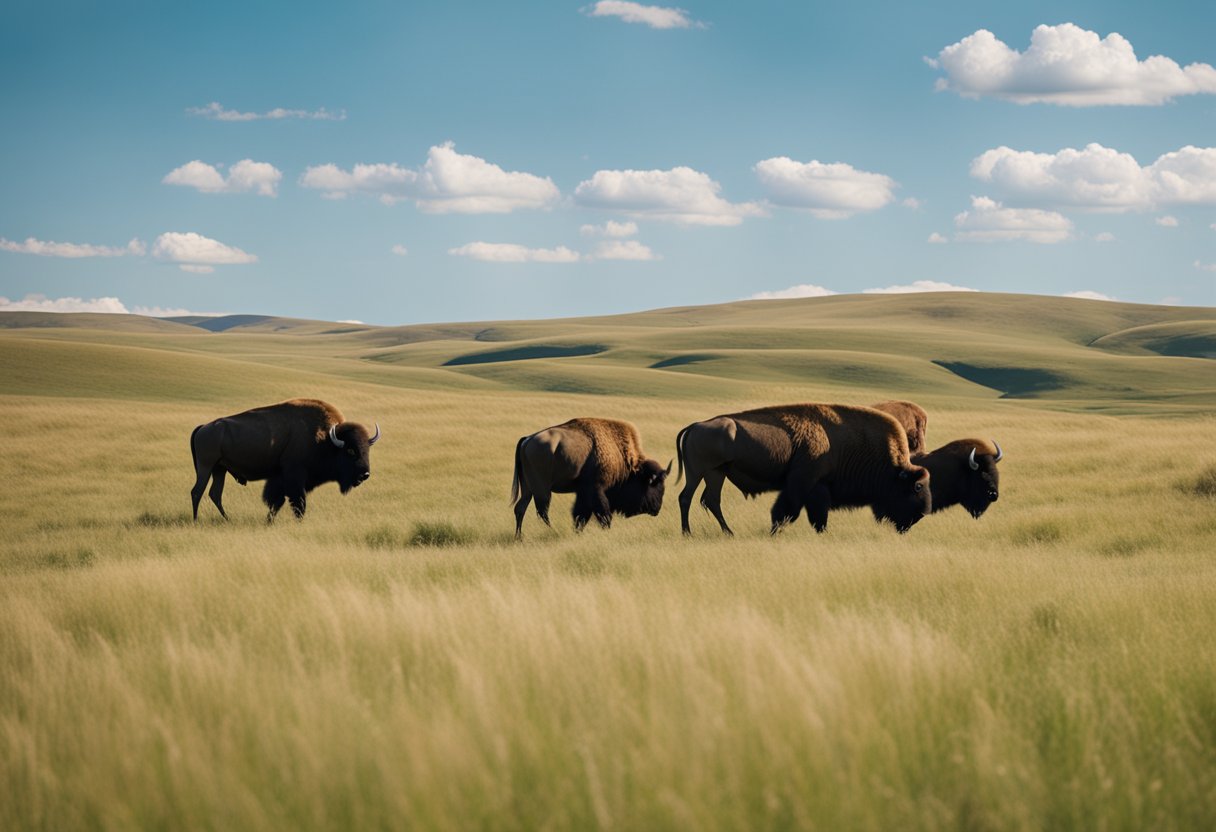
Updated On: March 28, 2024 by Eman Sameh
Across North America, the American bison stands as a symbol of strength, resilience, and cultural heritage. This majestic creature, once roaming the plains in vast herds, has become a powerful emblem of the continent’s natural history and pre-colonial legacy. The story of the bison is not just one of ecological importance but also of profound significance to the Indigenous peoples for whom the bison has held and continues to hold spiritual and practical value.

However, the journey of the bison has been fraught with peril. By the turn of the 20th century, this keystone species, which played a critical role in the health of the prairies, had been hunted nearly to extinction. The deliberate efforts to conserve the bison have since gained momentum, characterised by collaborations among conservationists, governments, and Native American tribes. This union of forces aims not only to restore bison populations but also to preserve the cultural connections that are integral to many communities’ identities. The challenges of bison conservation are significant, involving habitat management, legislative protection, and the navigation of human-bison conflicts, yet the collective commitment to these giants of the plains represents a beacon of hope for their future.
The Historical Range of the American Bison
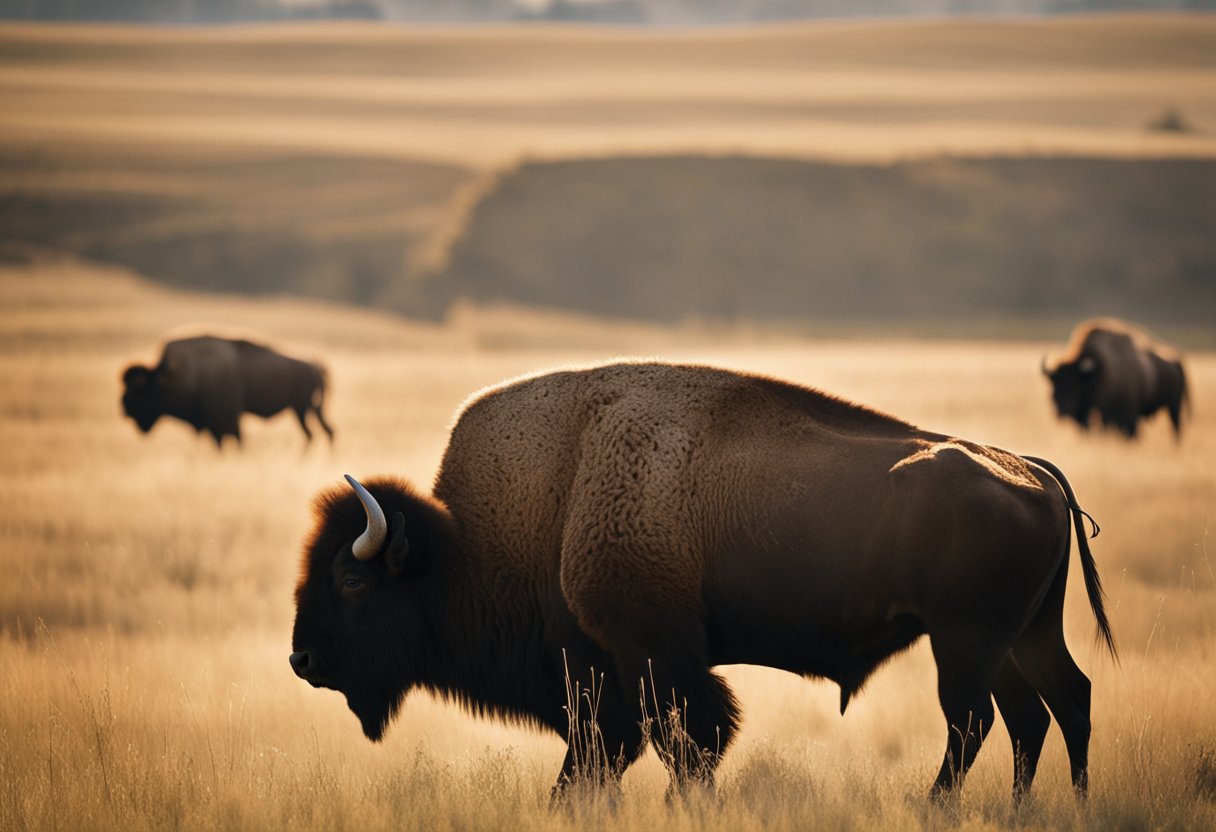
The American bison, also known as Bison bison, once roamed across North America in vast numbers, shaping ecosystems and cultures. Our exploration into their range reveals a dramatic shift from prehistoric abundance to the brink of extinction.
Prehistoric Distribution and Abundance
Before the arrival of European settlers, the bison’s domain stretched impressively across vast swathes of land. In particular, their range extended from the forests of Alaska and Canada through the grasslands of the United States, reaching as far south as Mexico. The great bison belt was a tract of rich grassland that hosted these colossal mammals, with their abundance symbolising the ecological richness of North America during prehistoric times. The original distribution included two subspecies: Bison bison bison, the plains bison, and Bison bison Athabasca, the wood bison, each adapted to different habitats within the continent.
Evidence suggests that the bison played a critical role as an ecosystem engineer. Their grazing patterns encouraged plant diversity, spread seeds, and maintained grass height, benefiting a diverse array of other wildlife.
Impact of European Settlers
With the advent of European colonisation in North America, the bison faced unprecedented challenges that led to drastic reductions in their numbers. By the late 1800s, European settlers had initiated a wave of overhunting and habitat destruction that nearly erased bison from existence. The population plummeted to fewer than a thousand from an estimated tens of millions by the late 19th century. This near-miss with extinction was orchestrated not only due to hunting for sport and sustenance but also as a part of policies intended to subdue Indigenous populations who relied on the bison.
Conservation efforts, including measures taken at Yellowstone National Park, were crucial in preventing the total loss of the species. Our appreciation of these majestic creatures’ historical range underscores the importance of ongoing conservation to ensure that the bison continue to thrive across North America’s landscapes.
The Bison as a Keystone Species
The American bison plays a pivotal role in maintaining the health and balance of North America’s grasslands. As a keystone species, their ecological impact is profound, shaping habitat and affecting diverse species across the trophic cascade.
Ecological Role and Impact
Bison are integral to the ecology of the grasslands. Their grazing patterns create a mosaic of plant life that supports varied grassland ecosystems. Through grazing, bison reduce the dominance of certain plant species which allows a diverse array of plants to thrive. These different plant communities provide niches for numerous wildlife species, bolstering biodiversity.
Their activities, such as wallowing—in which bison roll in the dirt, creating shallow depressions—can lead to the formation of small ponds that serve as a water source for wildlife and promote the growth of aquatic plants. These impacts are essential for the grasslands’ sustenance and for retaining soil moisture and nutrients.
Interactions With Other Wildlife
The presence of bison benefits a wide range of wildlife. For instance, pronghorn and elk utilise the diverse habitats that bison help create. Their grazing encourages the growth of new plant shoots, which in turn serve as a food source for animals like deer.
Wolves, bears, and other predators are also linked to bison, with these larger mammals often serving as prey, thereby supporting a healthy predator population. This dynamic prevents overgrazing and contributes to the maintenance of a balanced ecosystem. Moreover, the paths created by bison migrations help many smaller species move through dense vegetation.
Through their deep impact as a keystone species, bison shape the landscape and support a complex web that includes flora and fauna of all sizes. Their conservation is vital for continuing these rich ecological interactions across North America’s grasslands.
Cultural Importance of Bison to Indigenous Peoples
To Indigenous peoples of North America, the bison is more than an animal; it’s a vital component of their spiritual existence and a foundation of their material culture. For Plains tribes such as the Lakota, the bison influences ceremonies, traditions, and everyday life.
Spiritual and Material Significance
The bison holds a central spiritual role within many tribes, interwoven with their creation stories and religious ceremonies. Indigenous peoples have a profound relationship with the bison, seeing it as a symbol of sacrifice and a provider of life. Tribes like the Lakota invoke the bison in their rituals, acknowledging its gift of resources that are essential for survival.
Materially, the bison is integral to the tribes’ self-sufficiency. Practically every part of the bison is used. Plains Indians create clothing, shelter, tools, and more from bison, epitomising a sustainable ethic that honours the animal’s spirit. This deep connection to the bison is a testament to the values of respect and balance in using natural resources, underpinning Indigenous concepts of food sovereignty and ecological stewardship.
Efforts in Cultural Restoration
Restoring bison populations to tribal lands is a key component of cultural restoration for Indigenous peoples. By reintroducing bison, tribes such as the Lakota are reclaiming an essential part of their heritage, reinforcing sovereignty, and revitalising cultural practices linked to the bison.
Efforts to return bison to Indigenous territories revitalise cultural practices and promote ecological restoration of the grasslands. As tribes regain management of bison herds, they reinforce their historic role as stewards of the land, actively participating in conservation and restoring the natural balance of their ecosystems.
As we work towards these goals, we foster a future where Indigenous traditions are upheld and the sacred bond between tribes and the bison is honoured. Our dedication to this cause is a commitment to the respect of culture, land, and the enduring legacy of the original stewards of the American plains.
Conservation Efforts and Challenges
In addressing the conservation of bison, it’s essential to acknowledge both the progressive steps taken through restoration programmes and the persistent threats that challenge the recovery of bison populations.
Restoration Programmes and Strategies
Strategic restoration efforts aim to bolster bison conservation and promote biodiversity. The 2020 Bison Conservation Initiative has reinforced commitments to maintain large, wild, and genetically diverse herds. It underscores the importance of genetic diversity to the health of bison populations. Cooperative strategies, such as bottom-up collaborations and economic incentives, are crucial in overcoming conservation barriers.
Bison restoration also wrestles with cattle introgression – the mixing of bison genes with domestic cattle – which can undermine the genetic purity of bison herds. Therefore, it is vital to implement measures that track and maintain the genetic integrity of bison.
Threats to Bison Population Recovery
The recovery of bison is met with several challenges:
- Diseases: Bison herds can be afflicted by naturally occurring diseases and transmitted through contact with livestock, which can devastate populations.
- Disturbance: Human disturbances, including land development and fencing, disrupt traditional migratory patterns and habitat.
Conservation efforts must systematically address these obstacles to ensure the sustainable recovery of the bison. Ensuring secure habitats, enforcing disease control measures, and promoting policies that minimise human-induced disturbances are pivotal in overcoming these challenges.
The Role of Protected Areas and Legislation
Protected areas and legislation play critical roles in conserving North America’s bison, ensuring these iconic creatures thrive for future generations. By creating sanctuaries and enforcing protective laws, we cater to both ecological and cultural imperatives.
National Park Service Involvement
The National Park Service (NPS) is pivotal in bison conservation efforts. Yellowstone National Park is not only a bastion for wildlife but also a site that maintains one of the few unbroken lineages of wild bison. Similarly, Wind Cave National Park offers a sanctuary for bison, promoting their natural behaviours and genetic diversity. These parks, overseen by the Department of the Interior (DOI), provide approximately 4.6 million acres of habitat across the United States.
Federal and Tribal Regulations
Legislation and federal regulations, guided by entities such as the U.S. Fish and Wildlife Service and the Bureau of Land Management, govern the protection of bison on public and tribal lands. These combined efforts ensure sustainable populations through strategies, including managed hunts and transfer programmes, which are vital to the animal’s well-being and to honour the cultural ties Indigenous peoples have with the bison. These regulatory frameworks safeguard not only the bison but also the ecosystems and cultural heritage they represent.
Science and Bison Management
We understand the need for science-driven strategies in conserving and managing North American bison. This encompasses genetic management to ensure biodiversity and metapopulation and habitat management to maintain resilient, self-sustaining herds across various landscapes.
Genetic Management and Biodiversity
Bison, the iconic species of North America’s prairies, depend on genetic diversity to thrive. Our approach involves careful genetic monitoring to avoid inbreeding and maintain a diverse gene pool. This precaution aids in adapting to diseases and changing environmental conditions. Preservation of genetic variation in bison herds is vital for their long-term viability.
Metapopulation and Habitat Management
The metapopulation management of bison considers the dynamics of separate herds across different habitats. We take into account ecological principles to manage herds across fragmented landscapes, focusing on habitat connectivity that allows for natural migration and gene flow. It’s a delicate balance, managing the interplay between bison populations and their habitats to mimic historical patterns that are critical for species resilience.
Bison in Economy and Its Impact
Bison has become a cornerstone of economic development and ecotourism. We explore their contribution to various sectors and the implications for conservation and education.
Economic Development Through Bison Industries
Bison ranching has evolved into a significant industry, supporting economic development, particularly in rural communities. By managing commercial herds, producers sell bison meat, which is renowned for being a leaner and more environmentally sustainable alternative to traditional livestock. The industry doesn’t only pertain to meat production; by-products such as hides and bones are utilised in crafting, adding to the economic tapestry.
Additionally, the resurgence of bison herds on tribal lands exemplifies how cultural practices intertwine with commercial ventures, leading to diversified income streams through sustainable practices.
Educational and Ecotourism Opportunities
With the reestablishment of bison across North America, ecotourism has boomed. This form of tourism generates revenue while fostering conservation efforts. Visitors to reservations and national parks are eager to witness bison in their natural habitat, directly contributing to the local economy through fees, lodgings, and guided tours.
Education plays a pivotal role in ecotourism. We see this as we integrate information about bison ecology into tours, enhancing public understanding of these magnificent animals and their role in ecosystems. Such educational opportunities reinforce the importance of bison in cultural heritage and environmental stewardship, further supporting conservation narratives.
Private and Public Sector Collaboration
In our efforts to conserve the majestic bison of North America, we recognise the significance of cohesive efforts between private entities and public authorities. This collaboration ensures that bison herds thrive ecologically, culturally, and economically within their historical range.
Interagency Coordination
Our work involves strategic interagency coordination between federal and state wildlife agencies. These agencies come together to form the Bison Working Group, a collective that draws expertise and resources from both tiers of government. They establish policies and guidelines that benefit bison conservation while balancing ecological and social interests. Organisations like the InterTribal Buffalo Council also play a crucial role, representing Native American tribes that have a vested interest in restoring and managing bison populations.
Partnerships With Conservation Organisations
We actively foster partnerships with conservation organisations, pooling resources and knowledge to further bison conservation efforts. These collaborations with entities such as conservation partners create networks that provide essential support for managing and increasing bison populations across public and private lands. Through these partnerships, we connect conservation science with on-the-ground action, promoting initiatives like rewilding projects and habitat restoration that benefit not just bison but entire ecosystems.
Bison Behaviour and Habitat Preferences
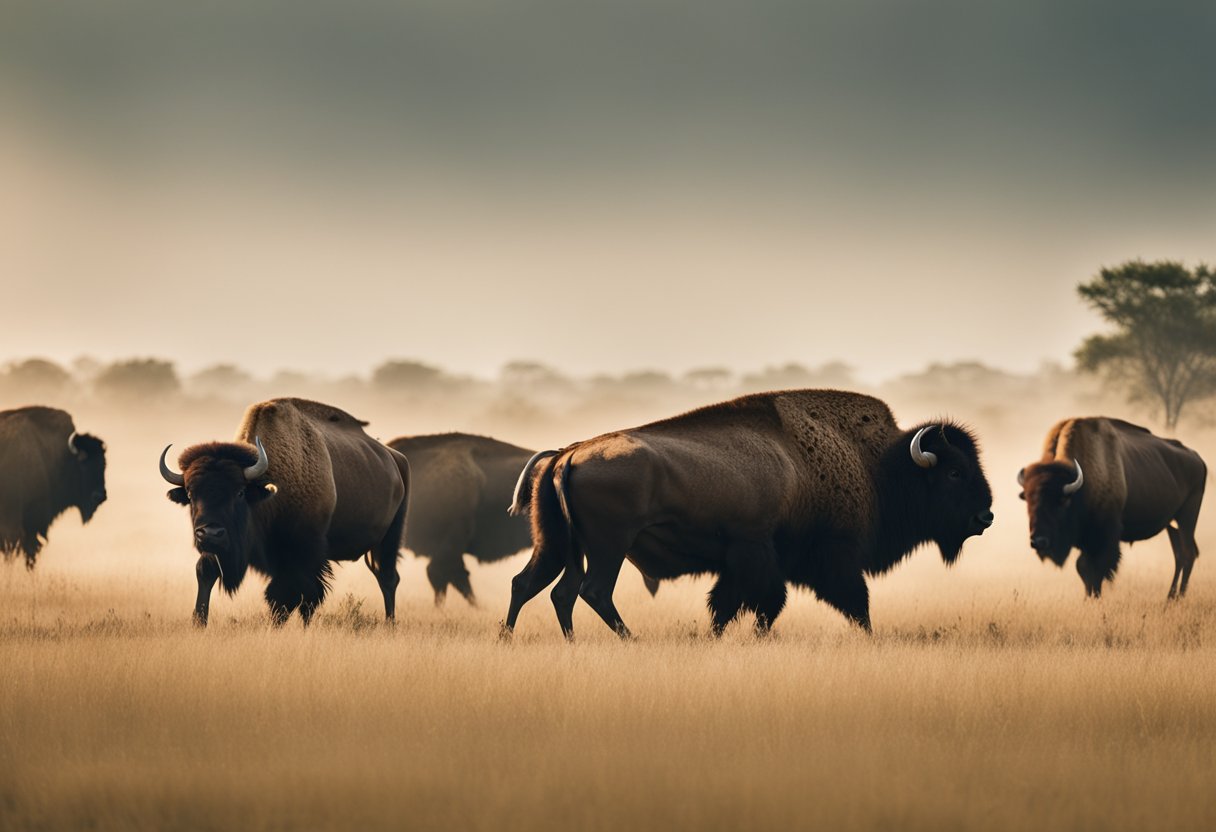
In exploring the various facets of bison life, we notice a complexity in their social interactions and a purposefulness in their movement across the plains. The following will illuminate the structures and patterns pivotal to their existence.
Social Structure and Herd Dynamics
Bison herds exhibit a well-defined social structure with a clear delineation of roles based on gender and age. Within these herds, male bison are known for their linear dominance hierarchies; the most dominant bull leads the group, followed by those with descending levels of influence. Notably, these herds are often segregated by sex outside the mating season. Females form nursery groups, integral in raising and protecting the young, while males may roam alone or form smaller bachelor groups.
The social fabric of bison herds is meticulously maintained through various behaviours. For example, wallowing—where bison roll in dirt depressions—is a method of ridding themselves of parasites, displaying strength and aiding in social bonding.
Grazing Patterns and Habitat Use
Bison are well adapted to life on the plains, utilising vast areas for their grazing patterns. They prefer grasslands that offer a diverse array of grass species, and their grazing behaviour encourages plant diversity and the health of the prairie ecosystem. Bison will migrate seasonally to find adequate food supply, traversing through their habitat with a keen awareness of their nutritional needs.
Fences and other man-made barriers can disrupt these natural movements, leading to grazing patterns and habitat use changes. Bison are heavy and robust animals, identifiable by their distinctive shoulder hump, which furnishes them with the strength to forage through snow and roam across various terrains in their pursuit of suitable grazing areas.
In maintaining this balance between their behavioural inclinations and the availability of resources within their habitat, bison play a pivotal role in the ecology of the grasslands. Their movements and grazing patterns contribute to their environment’s dynamic processes.
Influence of Climate on Bison Ecology
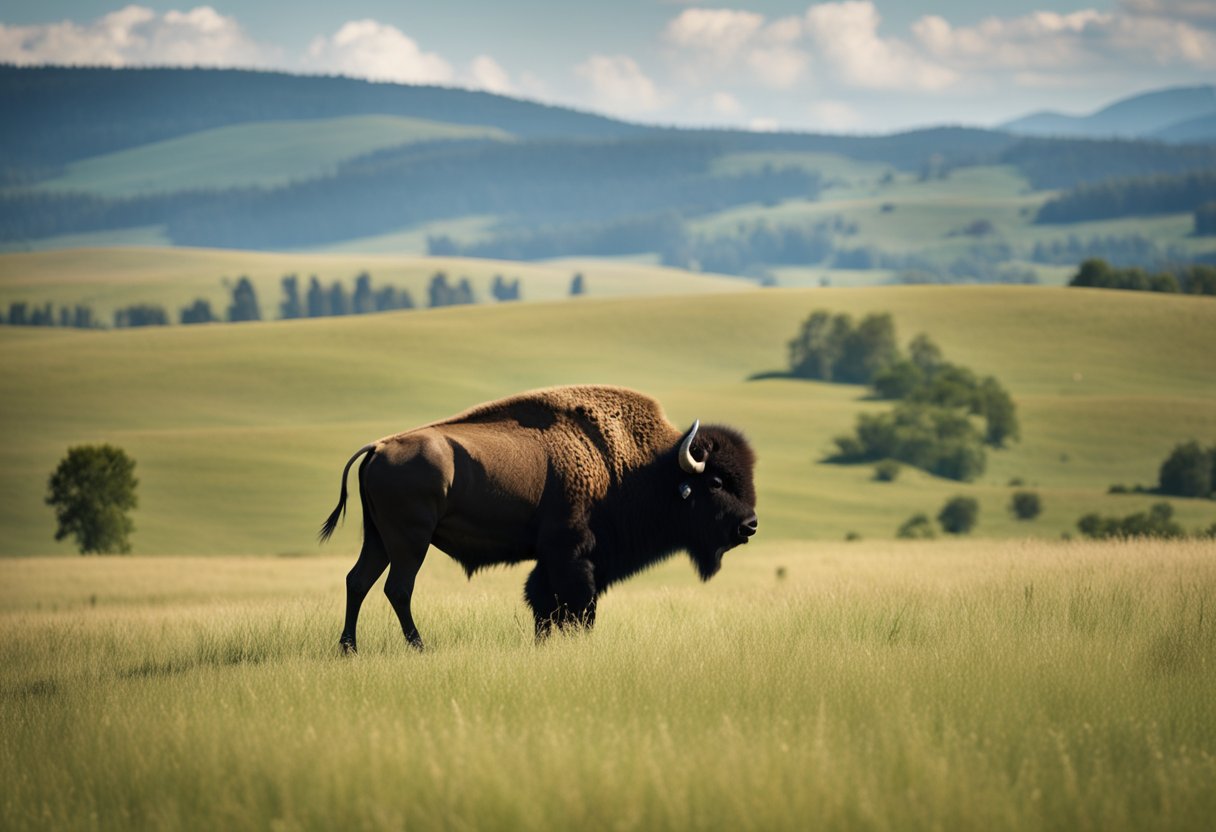
The North American bison endures as an emblem of the grassland ecosystem, yet climate change poses a substantial threat to its habitats. Alterations in weather patterns that dictate bison movement and access to food seriously impact conservation.
Climate Change Effects on Habitat
Climate change is anticipated to exacerbate wildfire conditions and alter vegetation across the habitats that bison depend on, such as the shortgrass prairie. The Potential of Bison Restoration as an Ecological highlights that warming trends could undermine the sustainability of current agricultural practices, which would, in turn, affect bison indirectly through changes to their food resources. Droughts, as well, are poised to become more frequent and severe, leading to a loss in the nutritional value of wild grasses, upon which bison profoundly rely.
Adaptations to Environmental Stressors
Despite these challenges, bison are capable of adapting to a variety of environmental stressors. They have historically coexisted with periodic fire and grazing, which maintain the grasslands’ health. More so, research indicates that bison movements change with weather, suggesting they might instinctively shift their patterns in response to climate change-induced stressors. However, this adaptability does not negate the need for proactive conservation efforts as the pressures from climate change continue to mount.
We must consider the implications of these environmental stressors on bison ecology and factor them into our conservation strategies to secure a future for the species synonymous with North America’s vast grasslands.
Frequently Asked Questions
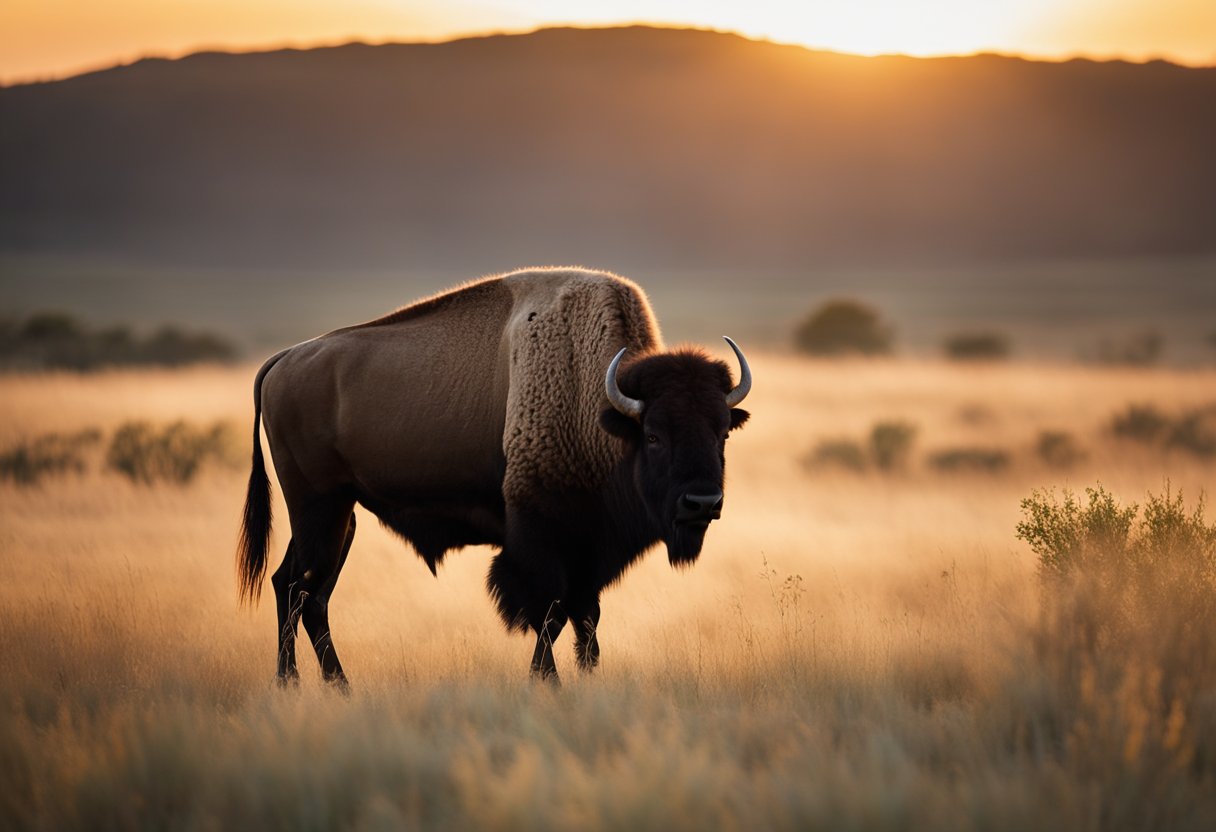
This section addresses some of the most common inquiries regarding the bison, a majestic creature with profound cultural and ecological importance.
What distinguishes the bison from the buffalo?
Often confused, the terms bison and buffalo actually refer to different species. North American bison are distinct from buffalo found in Africa and Asia, possessing thicker coats and a large shoulder hump.
Could you share several interesting facts about bison?
Despite their massive size, bison are remarkably agile. They can run up to 35 mph and change direction quickly, skills that are critical when eluding predators.
What is the current population count of American bison?
From an estimated 30 to 60 million historical population, the American bison population faced near extinction in the 1800s. Today, conservation efforts have helped their numbers rebound to approximately 31,000 wild bison.
What habitats are crucial for the survival of bison?
Bison thrive in grassland ecosystems, where they play a keystone role. Their grazing habits are essential for maintaining the balance and biodiversity of native prairies.
What historical importance do bison hold in indigenous cultures?
For many Indigenous peoples, the bison is a sacred symbol, integral to their sustenance, culture, and spirituality. This animal is deeply interwoven with their history and traditions.
Why is it imperative to focus on bison conservation efforts?
Bison conservation is vital for the species’ role in ecosystem integrity and cultural heritage. Initiatives aim to maintain large, wild, genetically diverse populations to ensure bison remain a part of North America’s natural legacy.






